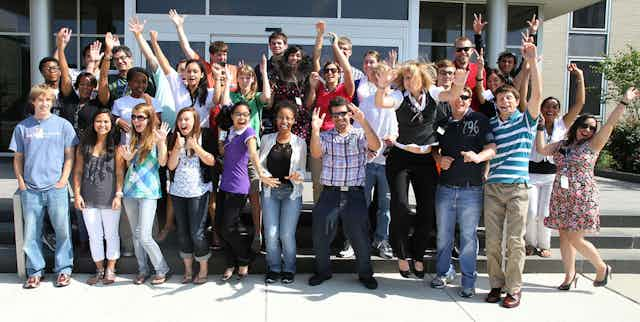Lack of exposure to a particular influenza strain means you won’t have had a chance to build up complete immunity. And if the strain spreads easily between people and there is little immunity in communities, this can lead to pandemic status. In 2009, the emergence of a new strain of influenza – A/H1N1, or swine flu – was declared a pandemic by the World Health Organisation, which put the death toll at over 18,000 people. A recent study suggested that this figure could have been up to ten times higher.
It is reasonable to assume there will be more influenza pandemics in the future. Historical records show that pandemics occur with startling frequency: flu pandemics occurred in 1889 (“Russian flu”), 1918 (“Spanish flu”), 1957 (“Asian flu”), 1968 (“Hong Kong flu”) and then in 2009 (“Swine flu”). The 1918 pandemic was one of the deadliest in human history and is believed to have killed up to 50m people worldwide.
Four more human cases of H7N9 were reported this week. But there has been much speculation and exaggeration of the risks posed by a number of these avian flu viruses.
Knowing how people get exposed to avian flu and how often these zoonotic infections (those that can cross between species) normally occur tell us not only about how these viruses evolve but can also put potential threats like H5N1 and H7N9 into a proper context.
Our work in the FluScape project in Southern China is helping us understand a lot about the human ecology of influenza in the region. For example, we’re examining how diverse people’s immunity to current and past influenza infections is. And we’re looking at how “patchy” immunity is between different villages and towns, even though they may be relatively close. We’re also trying to work out how often people in the region are exposed to avian and swine influenza strains.
Social networking
Being able to predict how fast a new flu pandemic will spread and what to do about it also demands an understanding of how normal flu spreads. Schools, where lots of small people with generally poor hygiene congregate on an almost daily basis, are known to be important drivers in the spread of influenza and many other flu-like illnesses.
I’ve been working closely with colleagues at the University of Pittsburgh, Johns Hopkins School of Public Health and the Centers for Disease Control and Prevention in the US on the SMART study. This study aims to help understand how children spread flu viruses in schools and beyond. Using a variety of methods, from questionnaires and electronic devices that record close encounters to video recordings, we’re quantifying the social mixing patterns of students and their interactions with the wider community.
Like other researchers, we’ve found that pupils’ social networks are dominated by encounters with similar-aged children – not surprising given they spend much of their within-school time in class with their peers. We’ve also been looking at how much interaction they have outside of schools to help understand whether deliberately closing schools would impact in the way people think on the spread of flu.
We’re also linking which students actually got flu or other infections in the school to their social networks, to determine exactly what sort of contacts, for example whether you spend a long time together or both handle the same object, might enable flu to spread, and how similar (or not) the spread of different viruses is.

The picture above shows just one friendship network that we recorded in an elementary school in Pittsburgh, Pennsylvania. Each circle is a student, and friendships are shown as a link between them. Students are colour coded by their school grade (A) and whether they got sick (B).
This work will be critical to help predict how far and how fast a new influenza strain with pandemic potential may really spread in the US – and potentially elsewhere. It will also help us to develop the best ways to mitigate transmission through closing schools or classrooms in the event of a new pandemic.
H + numbers
It is not, perhaps, surprising that we have seen a human case of H5N1 in a developed country outside of south-east Asia. The person concerned had visited China and it’s likely that’s where they caught the infection. But the risks of it spreading within Canada are extremely low; there have been more than 600 human cases worldwide in the the past decade and almost no evidence of human-to-human transmission. Put simply, it seems you catch H5N1 from handling sick birds, not from infected people.
The H7N9 strain is more worrying; it has caused more than 150 human cases in China and Hong Kong since it emerged just last year. It has a lower fatality rate than H5N1, but it is still more serious than normal seasonal influenza – a Hong Kong and Chinese-based team estimated that 36% of confirmed cases die from the infection and raised the possibility that only the most severe cases were identified.
The concern about H7N9 is really that there is some (limited) evidence that it can already spread between people. But so far, unless it mutates sufficiently, it doesn’t seem to do this easily.
While these viruses are still far from pandemics, we’re able to learn much from them – and to keep tabs on a virus that can rapidly evolve. Influenza viruses are difficult to predict with precision and as such remain a threat – one that requires research conducted in “peacetime” to help prepare ourselves for when another pandemic happens in the future.

